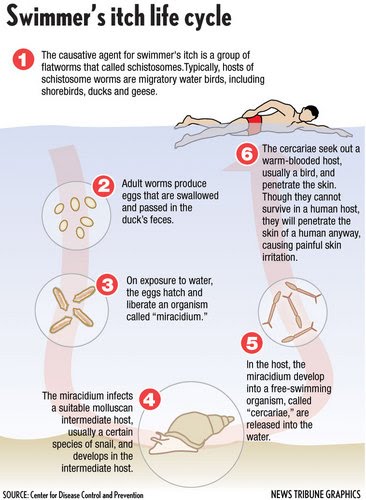

japonicum, 8 and perineal lesions with S. Urticarial lesions are more common with S.
SWIMMERS ITCH RELIEF SKIN
Papular, granulomatous, and even warty vegetating lesions of the genital and perineal skin secondary to the deposition of ova in dermal vessels 13,17,18 4.Įxtragenital cutaneous lesions secondary to lodgment of ova and, rarely, worms. Urticarial lesions associated with the dissemination of the cercariae or the laying of eggs by the adult flukes 3.

Seaweed can also cause a contact dermatitis.Ī pruritic, erythematous and urticarial papular rash (cercarial dermatitis, ‘ swimmer's itch’) associated with the penetration of the cercariae through the skin en route to the various venous plexuses to mature 16 2. Injuries to the skin from swimming in contact with coral can cause a contact dermatitis or mycobacterial infection. Jellyfish stings can cause a persistent contact dermatitis with eruptions that may recur for several months after the initial sting. Treatment is symptomatic, with topical steroids. The rash may persist for 2 weeks or longer. Pruritic, monomorphic, erythematous papules or vesicles develop within hours on areas which were covered by the bathing suit and new lesions may continue to occur for days after the initial exposure. Larvae of particular sea anemones become trapped in the bathing suit or wet-suit and pressure results in toxin release. Seabather's eruption is a relatively common dermatitis which occurs after swimming in sea water. At this stage, serology may be negative and in addition urine and stool may also be negative in the first 8 weeks after infection. Treatment with praziquantel should be offered. It is a clinical diagnosis, presenting with an itchy, papular rash and a history of swimming in infected freshwater. It occurs in sub-Saharan Africa, South-east Asia and parts of Brazil and Venezuela. Francisco Vega-Lopez, Sara Ritchie, in Manson's Tropical Infectious Diseases (Twenty-third Edition), 2014 Swimmer's Itch, Seabather's Eruption, Jellyfish and Coral InjuriesĬercarial dermatitis ( swimmer's itch) is caused by penetration of the skin by the free-living larval stages of the helminth schistosomiasis in freshwater lakes.


 0 kommentar(er)
0 kommentar(er)
